Theme 3: Connectivity and Movement

Introduction
The ease at which people move around impacts positively on our quality of life and boosts the attractiveness of Fingal as a place to live, work and visit. Similarly, the ease at which goods can be moved from place to place is one key element of an efficient and vibrant economy. Providing well-serviced, well-connected towns, villages and communities is a key aim of Fingal County Council. The policies and objectives of the Development Plan are instrumental in delivering a resilient County where compact growth facilitates the integration of land use and efficient transport systems. It also has a key role in attracting investment, reducing carbon emissions and making Fingal more resilient in the face of climate change.
The next Development Plan will aim to promote ease of movement throughout Fingal by integrating and enhancing existing areas as well as those settlements identified for growth, by promoting high quality connectivity through the delivery of footpaths, segregated cycling facilities, public transport systems, and high quality roads.
Fingal County Council recognises that public transport and the offering of alternatives to the private car are crucial in supporting Fingal’s ambitious sustainable transport and active travel objectives. Priority infrastructure investments for Fingal include transformational projects such as MetroLink, BusConnects and the implementation of the Greater Dublin Area Cycle Network Plan as well as the DART+ programme and the expansion of the LUAS network. These initiatives will bring about new and enhanced rapid rail links and a transformed bus network for the County. Combined with the establishment of a high-quality walking and cycling infrastructure network, these interventions will provide Fingal’s residents, visitors and businesses with flexible and sustainable focused travel choices.
The priority focus for the next Development Plan will be to reduce the negative impacts of car use in tandem with appropriate land use policies which will promote and facilitate effective travel options.This will include the identification of appropriate policies and objectives to ensure the efficiency and functionality of the road network, while also seeking to curb congestion.
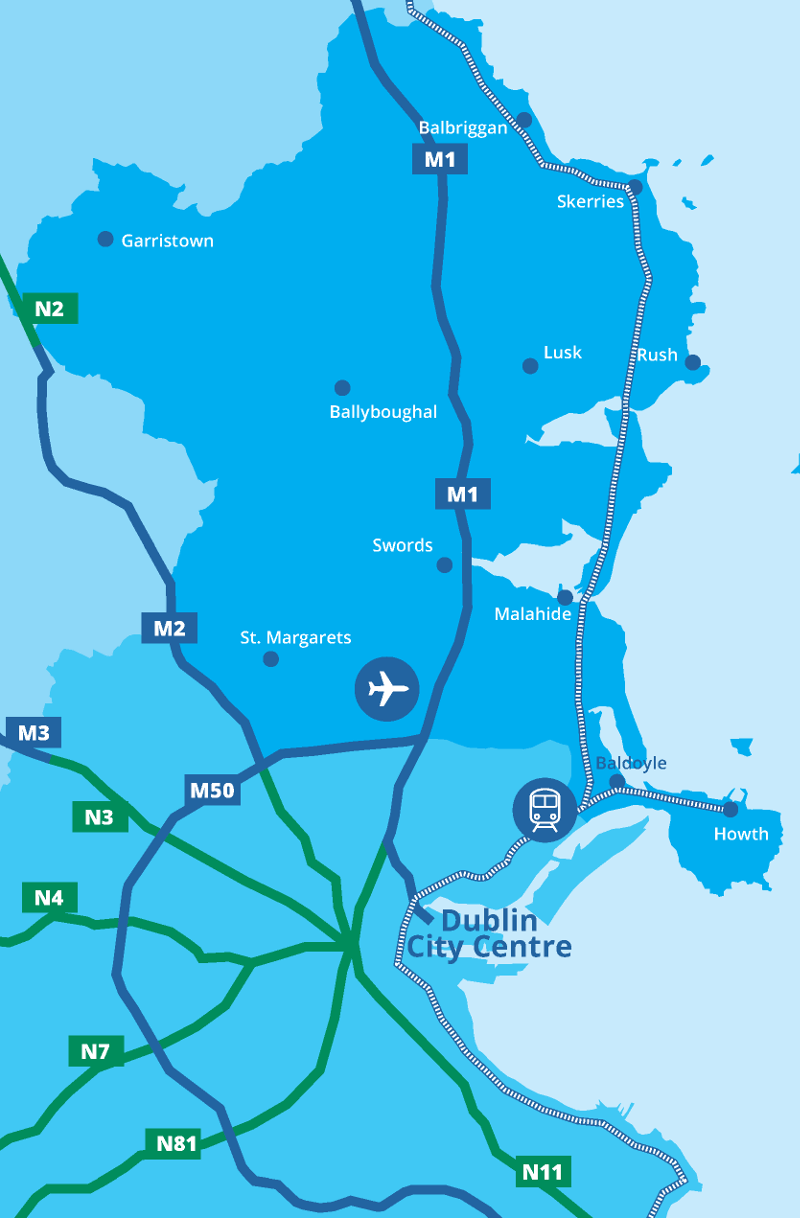
This in turn will enable the delivery of economic, environmental and quality of life objectives without the negative impacts of an inefficient transport network, air and noise pollution, congestion costs and carbon emissions undermining its long-term success.
Transport accounts for approximately 20% of CO2 emissions at national level and is the greatest consumer of energy and the highest contributor to noise and air pollution. Reducing emissions from transport is one of the major challenges facing society. Fingal County Council acknowledges the importance of transitioning to sustainable mobility solutions to mitigate against the negative impacts of transport and climate change. The Development Plan will seek to integrate land use and transportation policies, consolidating development and encouraging a shift from private car use to walking, cycling and public transport, thereby reducing emissions. Fingal County Council will continue to proactively engage with relevant transport providers to advance the delivery of key public transport infrastructure projects which will assist this modal shift.
Fingal benefits from strong transport connections through Dublin Airport, the Dublin Port Tunnel and its strategic road and rail corridors. The current network comprises key international and national routes including elements of the Trans European Network (TEN-T) This includes the M1 and M50 motorways which have the strategic function of catering for inter-urban and inter-regional traffic. Both the M1 and the Dublin – Belfast rail line provide critical transport connections within the Dublin – Belfast Economic Corridor. The strategic importance of benefits accruing from international connectivity through Dublin Airport, a core TEN-T Airport is also vital to the continued prosperity of Fingal.

Background and Context
Progress in terms of shifting to sustainable mobility can be measured in several ways including monitoring travel behaviours, clear land-use policy guidance and at a more localised level, through the planning and implementation of alternative mobility initiatives. A priority for the next Development Plan will be the promotion of more effective and sustainable travel options, including an overall vision to repurpose the existing road network to provide increased road space for pedestrians and cyclists. This approach, underpinned by the consolidation and strengthening of our towns and villages, will in turn promote efficiencies in our public transport network, reduce reliance on the private car and help to reduce CO2 emissions and transport derived energy consumption.
Travel Trends
Nationally, the travel behaviours of those commuting to work, school or college continue to exhibit an over reliance on the private car. Analysis from the Central Statistics Office from Census 2016 in relation to transport and travel shows nationally 58% of commuters travelling to work, school or college by private car. Notable changes in commuting patterns nationally between 2011 and 2016 related to the rise in the number of people who cycled to work which increased by 0.5% whilst those using public transport (i.e. bus, minibus, coach, DART or LUAS) remained constant at 12.9%. The average commute time also increased from 26.2 minutes to 27.4 minutes.
Within Fingal, slightly lower reliance on private cars was evident (51.8% of all commuters in 2016) whilst cycling and public transport modal share increased by 0.6% in both cases from 2011 to 2.8% and 20.5% respectively in 2016. Census 2016 shows that by far the greatest numbers of trips to work in Fingal are made by car, at 59.4% of all modes of transport. Bus and rail to work equates to 20.4 % while cycling to work equates to 2.5% with 5.4% getting to work on foot and a total of 12.3% for other alternative modes.
The above would appear to indicate a latent demand for more public transport and active travel infrastructure, thereby allowing people to make more sustainable transport options in their daily travel patterns if active travel alternatives were more readily available.
Achievements since the Previous Development Plan:
Since the adoption of the current Development Plan in 2017, Fingal County Council has actively sought to advance more sustainable and environmentally focused growth and mobility within the County. Long-standing policy objectives of the Development Plan aim to reduce car-dependency, align land-use and transport infrastructure, promote sustainable and active travel modes and tackle climate change through a reduction in emissions from transport. At the strategic level, Fingal County Council continues to integrate land use and transportation to achieve sustainable development through the progression of a number of Local Area Plans, Urban Framework Plans and Masterplans in line with national and regional policy objectives including the National Transport Authority’s (NTA) Transport Strategy for the Greater Dublin Area 2016-2035. Current land use policy has also developed in anticipation of planned strategic public transport investments which will directly benefit Fingal such as MetroLink, BusConnects, LUAS expansion and the DART+ programme.
Fingal County Council continues to protect the capacity and efficiency of its strategic air, road and rail corridors in collaboration with relevant stakeholders. For example, the Dublin Airport Local Area Plan adopted in January 2020 will accommodate the future sustainable growth and development of the airport lands while also facilitating the efficient and effective operation of airport facilities.
A number of initiatives are progressing a across the county with the aim of improving the public realm and promoting sustainable travel options. For example, a key component of the ‘Sustainable Swords’ project currently under preparation is the exploration of necessary sustainable transport interventions required in anticipation of MetroLink.
In addition major transportation schemes have been developed within Donabate, Swords and Baldoyle/Stapolin. Urban roads and streets within new and developing areas are being designed and constructed to facilitate increased levels of walking and cycling. Over the past six months substantial temporary measures have been put in place to expand the public realm and allocate more space for pedestrians and cyclists in response to Covid-19. E.g. Malahide.
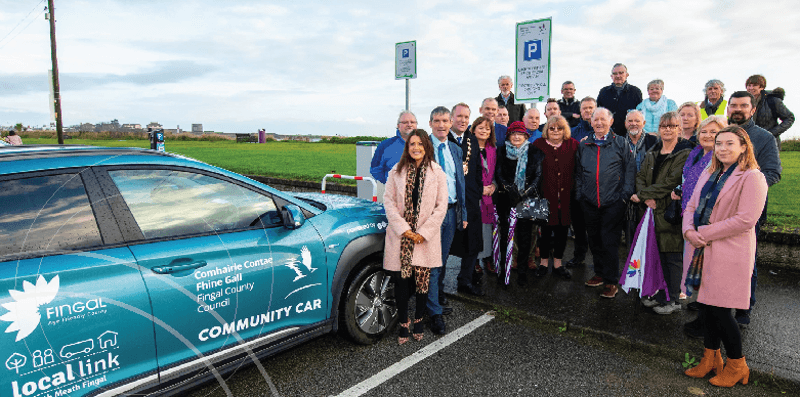
It will be important that the new Development Plan continues to implement policies and promote investment to ensure an appropriate transport hierarchy- ensuring high quality pedestrian and cycle facilities and high-capacity public transport options while also ensuring appropriate vehicular accessibility. Fingal County Council's three-year Capital Programme 2021-2023 allocates significant investment to transportation projects within the County which will facilitate cyclists, pedestrians and bus movement and improve traffic flows generally.
Fingal County Council has also been successful in securing funding and establishing new partnership arrangements with relevant stakeholders such as the NTA, TII and Irish Rail to deliver new and enhanced walking and cycling infrastructure. The recent establishment by Fingal County Council of the Environment, Climate Action and Active Travel Department demonstrates its commitment to advancing a network of walking and cycling routes central to enhancing the quality of residents and visitors alike. Fingal County Council’s Capital Programme for 2021-2023 also allocates significant funding of €146.69m to the development of greenway infrastructure. This will allow work to continue on delivering key walking and cycling projects within the County. Recent examples include the delivery of a 1.8km greenway linking Baldoyle to Portmarnock in July 2020. This greenway will in time, link into the 6km Broadmeadow Greenway connecting Malahide and Newbridge Demesne Regional Parks.

Following the successful grant of permission in May 2020 for this scheme, preparations for construction are advancing with works targeted to commence in 2021. The Sutton to Malahide Greenway scheme which will also link with these schemes is at emerging preferred route stage. The Fingal Coastal Way, a 32 km greenway linking existing towns along the coastal corridor from Donabate as far north as Balbriggan with the potential to link with planned strategic greenways in neighbouring counties, and the Royal Canal Greenway, will complete the strategic level greenway network in the county.
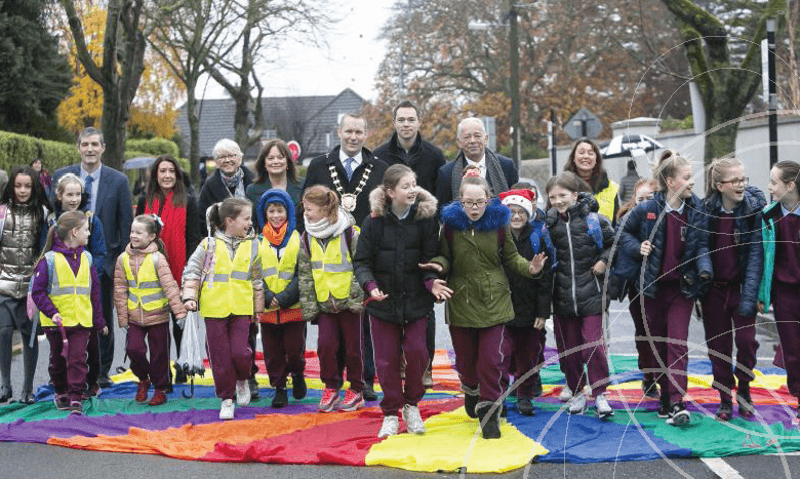
Supporting mobility initiatives have also been introduced across the county including bike sharing schemes, the use of car clubs as well as electric car charging points. There has also been a shift towards electric vehicles for Local Authority fleets.
Fingal County Council also supports the National Transport Authority’s Local Link bus service within rural Fingal which seeks to address social exclusion and integrate bus services where possible with existing routes.
Fingal was the first Local Authority in Ireland to launch a ‘Mobility Hub’ to support accessible and sustainable travel in Blanchardstown in 2020 which encourages varied and sustainable types of transport in areas close to existing public transport links with high concentrations of employment, housing, shopping, amenities and recreation.
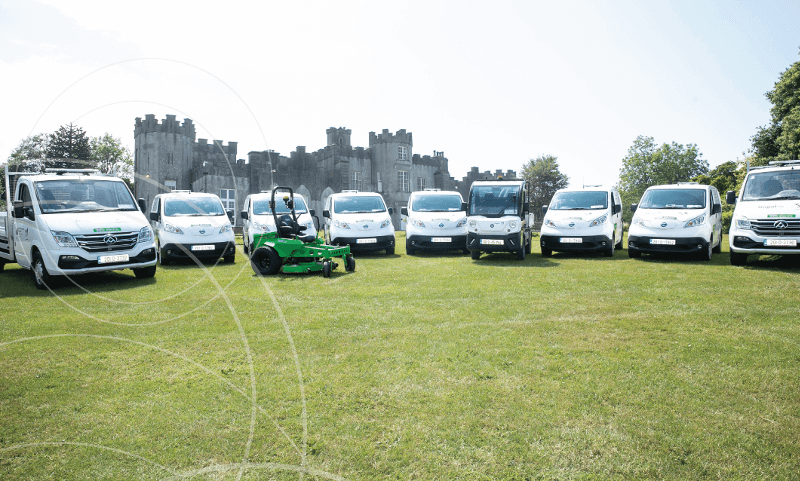
Key Issues for Next Development Plan:
Being well-connected locally, nationally and internationally makes Fingal an attractive place for people to live, visit and for businesses to invest, leading to multiple benefits for the County and wider region. The key issues facing Fingal in the context of shifting to more effective sustainable over the next plan period include the following:
Integration of Land Use Planning and Transportation:
It is vital that that there is increased integration between land-use planning and transport. This approach can provide a better quality of life within Fingal, ensure the economic and efficient movement of people and goods and reduce harmful impacts on the environment. Pursuing a policy of compact growth as advocated by national and regional planning guidance ensures that more people benefit from investment in enhanced public transport measures- be that high capacity bus and rail infrastructure or highly connected pedestrian and cycle networks.
Addressing climate change:
The reduction of emissions from transport presents one of the most significant challenges facing the county. Transport accounts for approximately 20% of CO2 emissions at national level and is the greatest consumer of energy and the highest contributor to noise and air pollution. Reducing emissions from transport is one of the major challenges facing society. Transition to a low carbon economy and addressing climate change will be a cornerstone of the new Plan.
Facilitating the Future Growth of Fingal that is less transport intensive:
As Fingal continues to grow in line with regional policy targets so will the need to travel and more connections will be required to access jobs, education, services, amenities and key destinations and attractions within the County. To allow Fingal to become a more progressive and environmentally focused, there is a need to ensure that this progress is not accompanied by growth in the use of the private car, thus worsening congestion and impacting economic growth, quality of life and carbon emissions. The Development Plan must identify the necessary policy framework to facilitate increased travel demand through a sustainable approach.
Priority for active and sustainable transport and a high level of public transport connectivity:
Pedestrian and cycle movement is now firmly recognised and supported by Fingal County Council as a critically important and attractive component of the County’s integrated transport network and considerable progress is being made in terms of extending the County’s cycling and walking infrastructure.
In addition, maximising the potential of rail and bus corridors is important as we achieve greater integration between land use planning and public transport in line with national and regional policy objectives. Higher densities and mixed-use developments must continue to be targeted in areas where opportunities exist for sustainable transport provision.
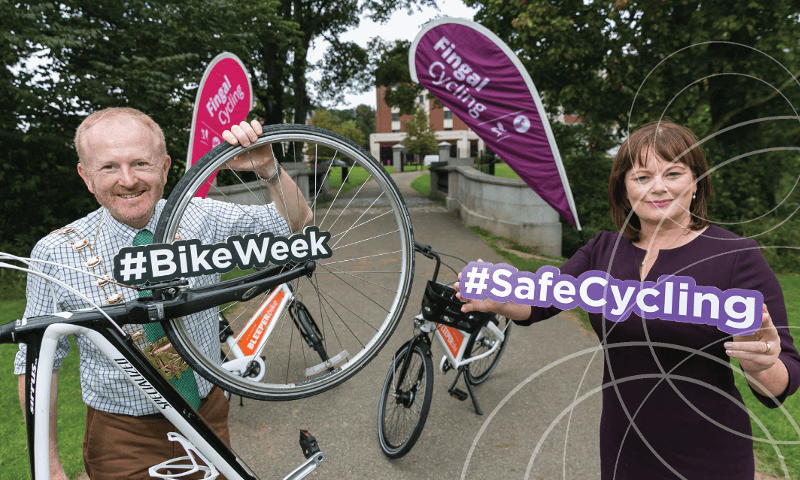
Enhancement of the public realm though traffic management and good design:
The gradual transfer of kerb-side space and other areas currently dominated by cars for use by pedestrians and cyclists will facilitate public realm enhancements making settlements accessible, attractive and safe for all ages and abilities. While encouraging the compact growth of existing settlements it will be important that in order to benefit from such consolidation, any barriers to active travel and the use of sustainable transport modes are identified. For example, the under provision of conveniently located and secure parking facilities may militate against the use of the bicycle for short trips.
In addition, a balance must be achieved between car usage, car storage and ensuring that our new residential developments are served by appropriate levels of parking, while not jeopardising the delivery of high-quality public realms. Proactive implementation of the Government’s Design Manual for Urban Roads and Streets 2019 (DMURS) will also assist in delivering successful public realms and sustainable and active transport modes, improving the overall quality of local neighbourhoods.
While striving to ensure a shift towards more sustainable modes of transport, our transportation networks must also accommodate those trips, which, in many instances can only be facilitated by road. This includes the movement of HGV’s from our national ports, trips generated to and from our distribution centres and more locally, the delivery of goods to our towns and villages. While such movements are a vital and necessary function of our transportation networks, measures to reduce or ideally eliminate high levels of congestion must be identified. This is a particular concern for our towns and villages where inappropriate use of HGVs for deliveries cause a myriad of issues. A proactive approach might include the use of smaller vans for
supplying shops/supermarkets.
Protection of Strategic Transport Corridors
The continued protection and enhancement of Fingal’s strategic air, road and rail corridors in accordance with national and regional policy objectives are vital for the future prosperity of the County, particularly in a post-Brexit environment. The rail and bus networks within Fingal play a key role in supporting future economic growth within the County and regionally.
Fingal is set to benefit from major rail and bus projects such as MetroLink, BusConnects and DART+ under the National Development Plan 2018-2027 which will serve key destinations and provide a high level of network integration and interchange. These projects, which are identified as key growth enablers for Fingal in the National Planning Framework will significantly increase capacity and allow more services to operate across the region, facilitating Fingal’s vision for compact growth and sustainable mobility.
As the primary gateway airport for the Country, Dublin Airport presents a significant opportunity to capitalise further on existing connections in attracting international inward investment and tourism. The National Planning Framework and the Regional Spatial and Economic Strategy for the region support the optimisation of our international and regional connectivity through investment and increased capacity in Dublin Airport.
The full potential of Dublin Airport will only be realised if surface access is protected and is commensurate with the quality of the transformed airport facilities and services. In particular, improved transport connectivity by a high frequency public transport enabling both passengers and employees to travel seamlessly to the Airport without the use of the private car is key to ensure that congestion does not undermine the Airport’s core function and long-term growth potential.
Sustaining Rural Communities
Fingal County Council recognises the importance of sustaining rural communities. Initiatives such as the NTA’s Local Link seeks to address social exclusion and integrate bus services where possible with existing routes. Addressing social exclusion by maximising accessibility in rural areas through support for rural transport will be a key consideration of the next Development Plan. At a more strategic level, the challenge is to ensure a sustainable pattern of development that integrates land use with transport and reduces the need to travel from more isolated areas to key centres of employment and services.
What Happens next?
Strategic transportation projects being actively progressed by Fingal County Council’s Planning & Strategic Infrastructure Department together with a dedicated focus on the promotion of behavioural change and active travel by Fingal’s newly established Environment, Climate Action and Active Travel Department will bring about a transformational change for the County, providing modern, efficient, integrated and environmentally focused travel options. As we look to the next Development Plan, it is important that continued investment is made in public transport together with the continued enhancement of active travel measures. There are a number of key questions to consider:
KEY QUESTIONS
- What are the key connectivity and movement issues affecting workers, residents and visitors within Fingal?
- How can we make it easier to get around Fingal?
- How can we ensure improved co-ordination between land-use and transportation infrastructure to achieve more sustainable development?
- How do we increase walking, cycling and public transport use and reduce car dependency?
- How can the safety of cyclists and pedestrians be improved? What measures could be put in place to make this happen?
- How can rural transport and accessibility be improved?
- What are the top priorities in meeting the mobility needs of all citizens in a fair and inclusive way?
- Should we be making greater use of shared community cars and bicycle schemes? What other mobility measures could be put in place to reduce car use?
- In your view, what are the key priorities to enhance Fingal’s strategic connectivity offered by its air, road and rail corridors?
- How can we reduce harmful emissions from transport?